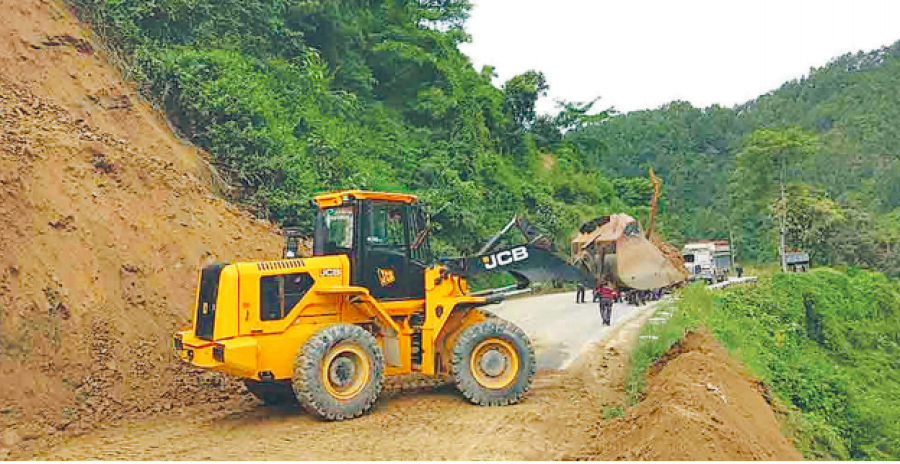National
Landslides, floods caused damages worth over Rs2 billion on national highways
Unplanned construction of rural roads and earthquake-hit geology blamed for the damages.
Prithvi Man Shrestha
Road infrastructure across the country have sustained damages worth over Rs2 billion this monsoon, as landslides and floods were reported in more than 150 locations along various national highways.
As the monsoon, which is expected to last till September, is still not over, damages to the country’s road network replete with unplanned and seismically fragile roads can’t be ruled out, officials say.
“Monsoon-induced disasters have caused damages worth over Rs2 billion on the national highways so far this year,” said Keshav Kumar Sharma, director- general at the Department of Roads. “During the entire monsoon last year, the total figure stood at Rs1.25 billion.”
Some of the major highways that sustained huge damages this monsoon are: Barhabise-Kodari section of the Araniko Highway, Naubise-Mugling section of Prithvi Highway, Beni-Jomsom road and Safe-Martadi road, according to the department.
But, overall, damages have been reported on nearly two dozen highways across the country in over 150 locations, according to the department.
Monsoon-induced damages were largely centred in the eastern part from the country last year. But, this year, more damages have been observed in the central and western parts, according to Sharma.
The largest damage was inflicted on the 61-km Dolalghat-Kodari section of Araniko Highway in Sindhupalchowk district, worst affected by the 2015 earthquake.
Bijaya Kumar Mahato, chief at the Division Road Office, Charikot, said that damages of around Rs1.5 billion have been reported on this section of the road where nearly one dozen landslides and as many floods have damaged the highway.
“We worked on the road and made it possible for vehicles to move on one lane from August 1,” said Mahato, who oversees the Sindhupalchowk section of the Araniko Highway.
“The geology of the district is such that it appears to be vulnerable to landslides, particularly after the earthquake. So, roads in the district usually see landslides during the monsoon,” said Mahato. “But, this year, there have been more damages than in the past.”
According to Mahato, the construction of auxiliary roads connecting the main highway by local governments without following norms, has emerged as another trigger for landslides and floods.
“We are tired of writing to local governments to stop the construction of unplanned roads,” said Shiva Hari Sapkota, spokesperson for the department.
Besides writing to the local government to stop reckless construction of rural roads, department officials say that they have also started utilising modern technology to prevent landslides on the highway.
“We used a geo-tech solution for preventing landslides on the Muglin-Narayangadh Road last year. As a result, only one-two big landslides happened on this road this year,” said Sharma. Geo-tech solution ( engineering) is a branch of civil engineering which is concerned with the behaviour of earth materials.
“We also plan to use the same technology on other highways. We are currently studying the possibility of using this engineering method on the Seti Highway,” he said.
According to the department, traffic has resumed on 76 locations where landslides and floods affected the highway. Similarly, a single lane has been opened in 60 other locations affected by landslides and floods.
Nepal remains vulnerable to many natural and human-induced hazards, says the Disaster Risk Reduction in Nepal: Status Report 2019. Floods kill nearly 150 people in Nepal every year. In the last nine years, 800 have died due to floods and another 900 in landslides. More than 700 are still labelled as missing.




 7.12°C Kathmandu
7.12°C Kathmandu













%20(1).jpg&w=300&height=200)

